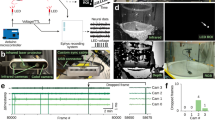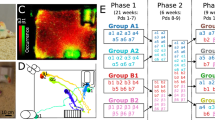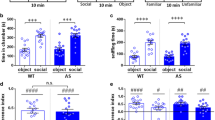Abstract
Despite recent advances, tracking individual movements safely and reliably over extended periods, particularly within complex social groups, remains a challenge. Traditional methods like color coding, tagging, and RFID tracking, while effective, have notable practical limitations. State-of-the-art neural network-based trackers often struggle to maintain individual identities in large groups for more than a few seconds. Fiducial tags such as ArUco codes present a potential solution to enable accurate tracking and identity management. However, their application to large groups of socially interacting mice in complex, enriched environments remain an open challenge. Here, we present the Tailtag system, a novel approach designed to address this challenge. The Tailtag is a non-invasive, safe, and ergonomic tail ring embedded with an ArUco marker allowing to track individual mice in colonies of up to 20 individuals in complex environments for at least seven days without performance degradation or behavioral alteration. We provide a comprehensive parameter optimization guide and practical recommendations for marker selection, for reproducibility across diverse experimental setups. Using data collected from Tailtag-equipped mice, we revealed the formation and evolution of social groups within the colony. Our analysis identified social hub regions within the vivarium where social contacts occur at different frequencies throughout one week of recordings. We quantified interactions and avoidance patterns between specific pairs of mice within the most active social hubs. Overall, our findings indicate that while the zone preferences and peer associations among the mice change over time, certain groups and pairwise interactions consistently form within the social colony.
This is a preview of subscription content, access via your institution
Access options
Subscribe to this journal
Receive 13 print issues and online access
$259.00 per year
only $19.92 per issue
Buy this article
- Purchase on SpringerLink
- Instant access to full article PDF
Prices may be subject to local taxes which are calculated during checkout





Similar content being viewed by others
Data availability
Video footage will be made available upon reasonable request.
References
de Chaumont F, Ey E, Torquet N, Lagache T, Dallongeville S, Imbert A, et al. Real-time analysis of the behaviour of groups of mice via a depth-sensing camera and machine learning. Nat Biomed Eng. 2019;3:930–42.
Weissbrod A, Shapiro A, Vasserman G, Edry L, Dayan M, Yitzhaky A, et al. Automated long-term tracking and social behavioural phenotyping of animal colonies within a semi-natural environment. Nat Commun. 2013;4:2018.
Roughan JV, Sevenoaks T. Welfare and scientific considerations of tattooing and ear tagging for mouse identification. J Am Assoc Lab Anim Sci. 2019;58:142–53.
Stockman H. Communication by means of reflected power. Proc IRE. 1948;10:1196–204.
König B, Lindholm AK, Lopes PC, Dobay A, Steinert S, Buschmann FJU. A system for automatic recording of social behavior in a free-living wild house mouse population. Anim Biotelemetry. 2015;3:39.
Bennett JP, Akram W. A review of RFID technology and its applications in animal tracking. Multi-animal pose estimation, identification and tracking with DeepLabCut, Multi-animal pose estimation, identification and tracking with DeepLabCut. Vet J. 2013;198:1–9.
Lauer J, Zhou M, Ye S, Menegas W, Schneider S, Nath T. et al. Multi-animal pose estimation, identification and tracking with DeepLabCut. Nat Methods. 2022;19:496–504.
Pereira TD, Aldarondo DE, Willmore L, Kislin M, Wang SSH, Murthy M, et al. Fast animal pose estimation using deep neural networks. Nat Methods. 2019;16:117–25.
Pérez-Escudero A, Vicente-Page J, Hinz RC, Arganda S, de Polavieja GG. idTracker: tracking individuals in a group by automatic identification of unmarked animals. Nat Methods. 2014;11:743–8.
Mersch DP, Crespi A, Keller L. Tracking individuals shows spatial fidelity is a key regulator of ant social organization. Science. 2013;340:1090–3.
Alarcón-Nieto G, et al. An automated barcode tracking system for behavioural studies in birds. Methods Ecol Evol. 2018;9:1536–47.
Eagan BH, Eagan B, Protopopova A. Behaviour real-time spatial tracking identification (BeRSTID) used for cat behaviour monitoring in an animal shelter. Sci Rep. 2022;12:17585.
Smith TJ, Smith TR, Faruk F, Bendea M, Kumara ST, Capadona JR, et al. Real-time assessment of rodent engagement using ArUco markers: a scalable and accessible approach for scoring behavior in a nose-poking Go/No-Go task. eNeuro 2024;11. https://doi.org/10.1523/eneuro.0500-23.2024.
Garrido-Jurado S, Muñoz-Salinas R, Madrid-Cuevas FJ, Marín-Jiménez MJ. Automatic generation and detection of highly reliable fiducial markers under occlusion. Pattern Recognit. 2014;47:2280–92.
Ge Z, Liu S, Wang F, Li Z, Sun J. YOLOX: Exceeding YOLO Series in 2021. arXiv. 2021.
Maji D, Nagori S, Mathew M, Poddar D. YOLO-Pose: enhancing YOLO for multi person pose estimation using object keypoint similarity loss. arXiv (2022).
Chen K, Wang J, Pang J, Cao Y, Xiong Y, Li X. et al. MMDetection: Open mmlab detection toolbox and benchmark. arXiv preprint arXiv:1906.07155 (2019).
Leal-Taixé L, Milan A, Reid I, Roth S, Schindler K. Motchallenge 2015: Towards a benchmark for multi-target tracking. arXiv preprint arXiv:1504.01942 (2015).
Duerler P, Vollenweider FX, Preller KH. A neurobiological perspective on social influence: Serotonin and social adaptation. J Neurochem. 2022;162:60–79.
Cid-Jofré V, Bahamondes T, Zúñiga Correa A, Ahumada Arias I, Reyes-Parada M, Renard GM. Psychostimulants and social behaviors. Front Pharmacol. 2024;15:1364630.
Feldman R. Social behavior as a transdiagnostic marker of resilience. Annu Rev Clin Psychol. 2021;17:153–80.
Lee W, Milewski TM, Dwortz MF, Young RL, Gaudet AD, Fonken LK, et al. Distinct immune and transcriptomic profiles in dominant versus subordinate males in mouse social hierarchies. Brain, Behav Immun. 2022;103:130–44.
Agranyoni O, Meninger-Mordechay S, Uzan A, Ziv O, Salmon-Divon M, Rodin D, et al. Gut microbiota determines the social behavior of mice and induces metabolic and inflammatory changes in their adipose tissue. NPJ Biofilms Microbiomes. 2021;7:28.
Choi TY, Jeon H, Jeong S, Kim EJ, Kim J, Jeong YH, et al. Distinct prefrontal projection activity and transcriptional state conversely orchestrate social competition and hierarchy. Neuron. 2024;112:611–627.e618.
Kupferberg A, Bicks L, Hasler G. Social functioning in major depressive disorder. Neurosci Biobehav Rev. 2016;69:313–32.
Saris IMJ, Aghajani M, van der Werff SJA, van der Wee NJA, Penninx B. Social functioning in patients with depressive and anxiety disorders. Acta Psychiatr Scand. 2017;136:352–61.
Green MF, Horan WP, Lee J. Social cognition in schizophrenia. Nat Rev Neurosci. 2015;16:620–31.
Addington J, Penn D, Woods SW, Addington D, Perkins DO. Social functioning in individuals at clinical high risk for psychosis. Schizophr Res. 2008;99:119–24.
Dickerson BC. Dysfunction of social cognition and behavior. Continuum. 2015;3:660–77.
Lord C, Elsabbagh M, Baird G, Veenstra-Vanderweele J. Autism spectrum disorder. Lancet. 2018;392:508–20.
Fu, D, Chen, D, Bao, J, Yang, H, Yuan, L, Zhang, L, et al. In Proceedings of the IEEE/CVF conference on computer vision and pattern recognition. 14750-9.
Acknowledgements
We would like to thank the animal facility at the CERVO Brain Research Center for their help in implementing the vivarium platform.
Funding
BL holds a Sentinelle Nord Research Chair, is supported by the Canadian Institutes of Health Research (Grant No. PJT-451728 and PJT-451858), and the Natural Science and Engineering Research Council of Canada (Grant No. RGPIN-2019-06496) and receives Fonds de Recherche en Santé du Québec (FRQS) Junior-2 salary support. AMR is supported by FRQS scholarships. BG holds the Canada Research Chair in Smart Biomedical Microsystem and is supported by the Natural Science and Engineering Research Council of Canada (Grant No. RGPIN-2022-03984).
Author information
Authors and Affiliations
Contributions
BL conceived the project, designed the experiments and wrote the manuscript. BG contributed to the experimental design of the experiments and reviewed the manuscript. VC designed the technical experiments, built the system’s software, performed the ArUco parameter selection, performed the analyses, made the figures and wrote the manuscript. AMR contributed to the analysis of social dynamics, contributed to the figures and to the manuscript. MSM designed the tailtags, generated the video data and contributed to the manuscript. DAR contributed to the ArUco parameter selection. QL and MRP contributed to the animal experiments and video data generation. All authors contributed to the preparation of the manuscript.
Corresponding author
Ethics declarations
Competing interests
The authors declare no competing interests.
Additional information
Publisher’s note Springer Nature remains neutral with regard to jurisdictional claims in published maps and institutional affiliations.
Supplementary information
Rights and permissions
Springer Nature or its licensor (e.g. a society or other partner) holds exclusive rights to this article under a publishing agreement with the author(s) or other rightsholder(s); author self-archiving of the accepted manuscript version of this article is solely governed by the terms of such publishing agreement and applicable law.
About this article
Cite this article
Coulombe, V., Rivera, A.M., Monfared, S. et al. The Tailtag: A multi-mouse tracking system to measure social dynamics in complex environments. Neuropsychopharmacol. 50, 1336–1345 (2025). https://doi.org/10.1038/s41386-025-02126-y
Received:
Revised:
Accepted:
Published:
Issue date:
DOI: https://doi.org/10.1038/s41386-025-02126-y



